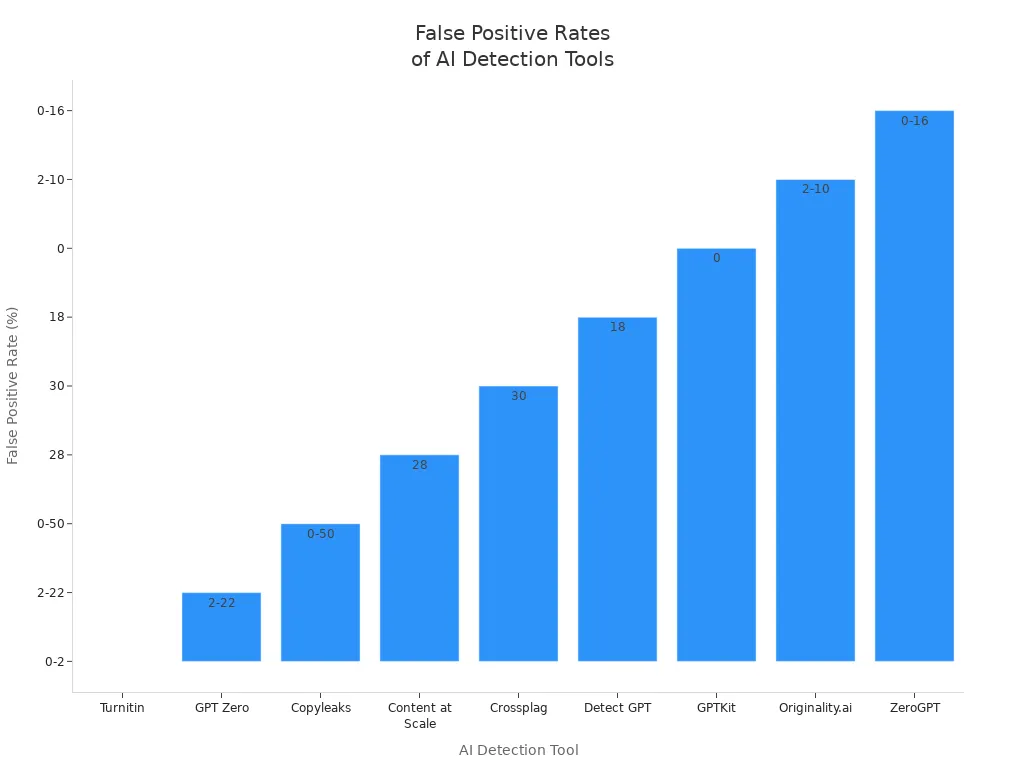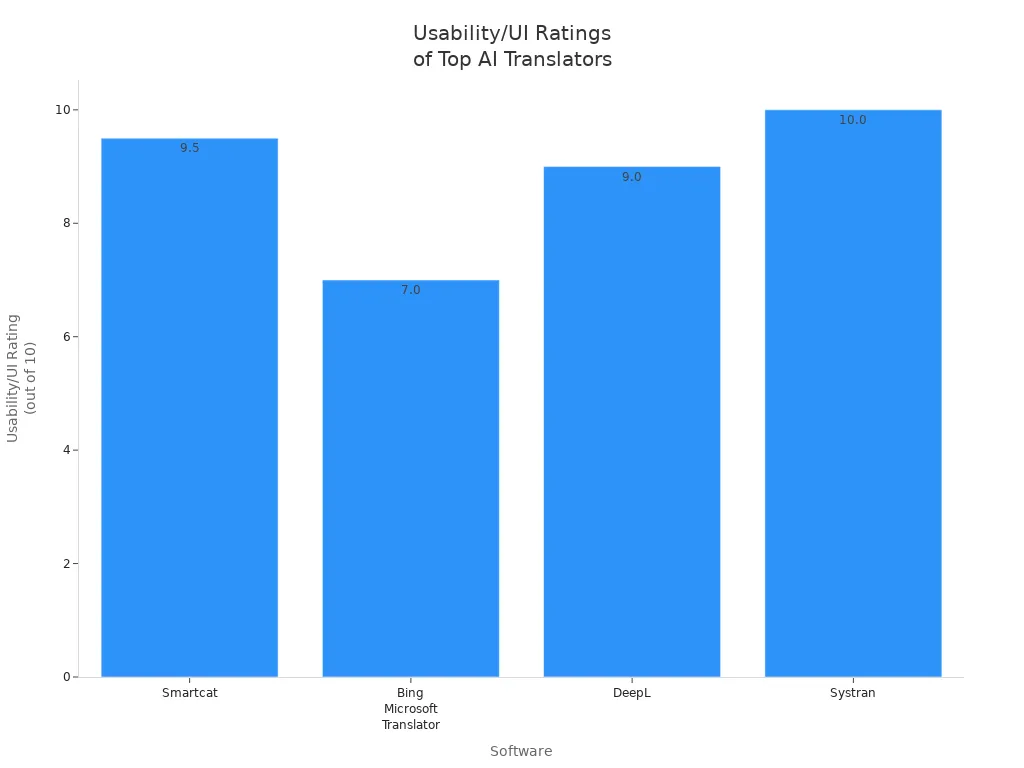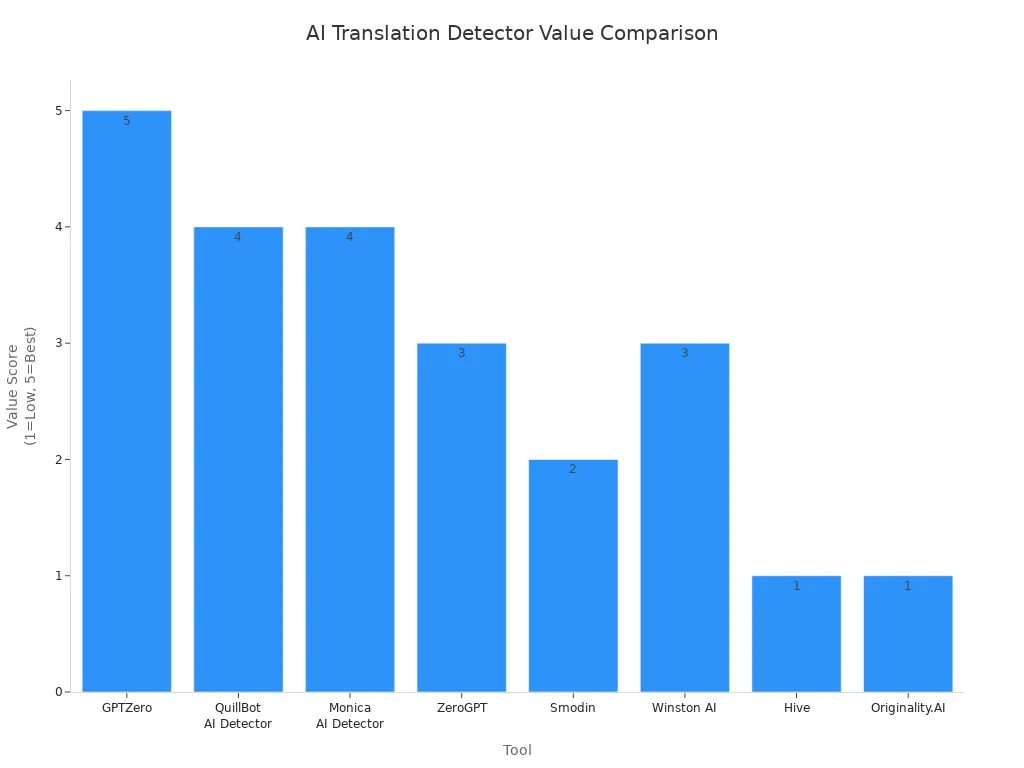
Winston AI, Copyleaks, ZeroGPT, and Originality AI are the best ai detector tools for translation in 2025. Each ai translation detector has special features for different users. Teachers often pick GPTZero and Scribbr. Companies like Originality AI and Copyleaks more. The best ai detector tools are great at accuracy, reliability, multi-language support, and fitting different needs. Important things for the best ai translation software are terminology precision, how well it works, and human checks. These ai detector solutions help with translation in schools, businesses, and making content.
Quick Takeaway:
For quick advice, look at the table below. It compares top ai translation detector tools by user group and accuracy.
|
AI Detector Tool |
Accuracy Level |
Primary User Groups |
Typical Use Cases |
|---|---|---|---|
|
GPTZero |
High |
Educators, Schools |
Academic translation detection |
|
Originality.AI |
Very High |
Businesses, SEO Agencies |
Editorial and compliance translation |
|
Copyleaks |
High |
Businesses, LMS Platforms |
Internal translation verification |
|
ZeroGPT |
Low Reliability |
Casual Users |
Casual translation detection |
-
Check ai translation detector solutions using these points:
-
Consistency in testing environments
-
Human checks for style and accuracy
-
Domain expertise and clear scoring rubrics
-
Many evaluators to lower bias
Key Takeaways
-
Top AI translation detectors like Winston AI, Copyleaks, and Originality AI are very accurate. They support many languages. This makes them good for schools, businesses, and people who make content.
-
Picking the best AI detector depends on what you need. Teachers like GPTZero. Businesses use Originality AI and Copyleaks. People who just want a quick check may like ZeroGPT.
-
Accuracy and trust are important. The best tools have over 97% accuracy. They use smart ways to lower mistakes.
-
How the tool works with other software is important. Tools that are easy to use help people work faster and better.
-
People still need to check translations. This makes sure the meaning and culture are right. AI tools are getting better and faster, but human review is still needed.
Top AI Translation Detectors
Leading Tools
In 2025, more people use ai translation software. Some ai detection tools are better at finding ai-generated text in translated files. Here are some of the most popular ai translation detector solutions:
-
Winston AI: This ai translation detector uses language study, deep learning, and special algorithms. Winston AI can spot ai-made images and read scanned files with OCR. It also has browser add-ons and gives PDF reports. Winston AI says it is 99.98% accurate. This makes it a top pick for businesses and schools that need exact ai detection.
-
Copyleaks: Copyleaks mixes ai logic with old plagiarism checks. It works with over 30 languages for ai detection and 100+ for plagiarism. Copyleaks can also find code in programming languages and has browser add-ons. Its cross-language plagiarism check and over 99% accuracy make it great for schools and companies.
-
ZeroGPT: ZeroGPT uses its DeepAnalyse™ algorithm to look at text structure, perplexity, burstiness, and language clues. It has tools for summarizing, paraphrasing, grammar checks, and translation. ZeroGPT says it is 98-99% accurate. It is good for people who want a fast ai work detector for quick or live translation checks.
-
Originality AI: Originality AI has three modes—Lite, Turbo, and multilingual. It works with over 15 languages and gives SEO readability scores, fact checks, full-site scans, and team tools. With over 99% accuracy, this ai translation software is for businesses, SEO agencies, and content makers.
-
GPTZero: GPTZero looks at perplexity and burstiness. It works with school platforms like Canvas and Moodle. It also has Chrome and Google Docs add-ons. Team dashboards and Zapier links make it popular with teachers. GPTZero says it is 99% accurate for ai content checks.
-
Smodin: Smodin mixes ai detection with rewriting, summarizing, translating, grammar checks, plagiarism checks, citation help, and an ai chatbot. It works with over 100 languages and scanned files. Smodin says it is about 91% accurate for ai detection but is easier to trick than other ai document detector tools.
Note: Passed.ai is not listed because there is not enough data for 2025.
What Makes Them Stand Out
Each top ai translation software has special features. The table below shows their main technologies and strengths:
|
Tool |
Unique Features and Technologies |
Accuracy |
Supported Languages |
Target Audience |
|---|---|---|---|---|
|
Winston AI |
Language study, deep learning, OCR, browser add-on, PDF reports, multi-user dashboards |
Up to 99.98% |
15+ |
Businesses, Academics |
|
Copyleaks |
AI logic + plagiarism, cross-language checks, code finding, browser add-on |
Over 99% |
30+ (AI), 100+ (Plagiarism) |
Education, Enterprises |
|
ZeroGPT |
DeepAnalyse™ algorithm, summarizer, paraphraser, grammar checker, translator tools |
98-99% |
15+ |
Casual Users, Content Creators |
|
Originality AI |
Lite/Turbo/multilingual modes, SEO scoring, fact-checking, full-site scan, team tools, API |
Over 99% |
15+ |
Businesses, SEO Agencies |
|
GPTZero |
Perplexity/burstiness, LMS links, Chrome/Docs add-ons, team dashboards, Zapier |
99% |
10+ |
Educators, Schools |
|
Smodin |
AI detection, rewriting, summarizing, translating, grammar/plagiarism checks, citation, chatbot, homework helper |
~91% |
100+ |
Students, Individuals |
Winston AI is best for accuracy and advanced ai detection in translated files. Copyleaks is great for many languages and cross-language plagiarism checks, so it is good for schools. ZeroGPT is fast and easy to use for real-time translation checks. Originality AI has strong team and SEO tools, which help businesses and content marketers. GPTZero is made for schools and works well with learning systems. It is very accurate for school translation checks. Smodin is good for students and people who want one tool for rewriting, summarizing, and translating.
Most ai translation detector tools work with many languages. Smodin and Copyleaks cover the most languages. Winston AI and Originality AI focus on high accuracy and smart neural detection. ZeroGPT and GPTZero are easy to use for quick translation checks. These ai detection tools help people translate text, check for ai-made content, and make sure documents are original.
The best ai translation software keeps up with new ai translation models and supports many languages. Businesses, teachers, and content makers use these tools to find ai-made text, follow rules, and make translations better. Top ai translation software uses neural networks and ai-powered neural machine translation for good results. They help people translate, check files, and handle many languages well.
AI Translation Detector Comparison

Feature Table
The best ai translation software in 2025 has many features. Each detector uses its own way to check text and find ai-made content. These tools help with translation in lots of languages. The table below shows the main features of top ai translation software and ai work detector tools:
|
Detector |
Accuracy |
Supported Languages |
Detection Methods |
Integration Options |
Pricing |
Target Users |
Notable Features |
|---|---|---|---|---|---|---|---|
|
Winston AI |
99.98% |
15+ |
Deep learning, OCR, neural analysis |
Browser add-ons, PDF reports |
Not disclosed |
Businesses, Academics |
Multi-user dashboards, advanced localization |
|
Copyleaks |
99%+ |
30+ (AI), 100+ (Plagiarism) |
Multi-layered linguistic analysis, code detection |
API, browser add-ons, LMS plugins |
Education, Enterprises |
Cross-language plagiarism, fast batch processing |
|
|
ZeroGPT |
98-99% |
15+ |
DeepAnalyse™, text structure, burstiness |
Web, browser extension |
Not disclosed |
Casual Users, Content Creators |
Real-time translation checks, summarizer |
|
Originality AI |
99%+ |
15+ |
AI + plagiarism detection, SEO scoring |
API, team dashboards, full-site scan |
$0.01/100 words |
Businesses, SEO Agencies |
|
|
GPTZero |
99% |
10+ |
Perplexity, burstiness, linguistic metrics |
LMS plugins, Chrome/Docs add-ons |
Free, paid from $8.33/mo |
Educators, Schools |
Educational feedback, ethical AI use |
|
Smodin |
~91% |
100+ |
Sentence-level AI classification |
Web, browser extension |
$10/month |
Students, Individuals |
Multi-functionality, tone/style checks |
Tip:
Copyleaks and Smodin work with the most languages. Winston AI and Originality AI are best for accuracy and smart detection.
Key Differences
Each ai translation software is good at something special. Winston AI is the most accurate for translation checks. It is great for businesses and schools that need exact results. Winston AI can scan many types of files, even scanned papers, using neural analysis and OCR.
Copyleaks is best for schools and big companies. It checks over 30 languages for ai and more than 100 for plagiarism. This makes it good for groups with people from many places. Copyleaks can connect with other software using API and LMS plugins. It also shows where ai text is and keeps records for rules.
ZeroGPT is made for fast checks. Its DeepAnalyse™ algorithm looks at how text is built and burstiness. This helps people see if a translation is real or not. ZeroGPT is good for content creators and people who want quick answers.
Originality AI is for businesses and SEO agencies. It checks for ai and plagiarism and helps teams work together. Users can see scan history, handle billing, and keep content original in many languages. It can scan whole sites and gives SEO scores. This helps web publishers who need strong translation tools.
GPTZero is the top choice for teachers. It uses perplexity and burstiness to find ai-made text. It works with LMS and Chrome add-ons, so teachers can check student work easily. GPTZero has a free option, so schools with less money can use it.
Smodin does many things in one place. It works with over 100 languages and lets users rewrite, summarize, translate, and check for ai. Smodin is liked by students and people who want one tool for homework or projects. But its accuracy is lower than other detectors, so it can be easier to trick.
Note:
Some detectors, like Winston AI and ZeroGPT, do not share much about how they connect or what they cost. Users should check each software’s website for the newest info.
The best ai translation software keeps up with new ai models and works with many languages. Businesses, teachers, and content creators should pick a detector that fits their needs. The right ai work detector will help with localization, keep text original, and make translation easier.
Metrics
Accuracy
Accuracy is the most important thing for any AI translation detector. It tells us how well the detector finds AI-made content in translations. Experts use different ways to check how accurate a detector is:
-
BLEU: Checks if word groups in the translation match the reference, but it might not catch the meaning.
-
ROUGE: Looks at how much important information from the reference is in the translation.
-
BERTScore: Uses AI to see if the translation and reference mean the same thing, even if the words are different.
-
Precision: Tells us how many flagged translations are really AI-made.
-
Recall: Shows how many AI-made translations the detector finds.
-
F1-Score: Gives a fair score by balancing precision and recall.
Winston AI says it is 99.98% accurate in 2025. This makes it one of the best for translation accuracy. The table below shows the newest accuracy numbers for top detectors:
|
Model Version |
Release Date |
Accuracy |
False Positive Rate |
Notes |
|---|---|---|---|---|
|
Winston AI 1.0.1 Lite |
June 2025 |
Over 99% |
0.5% |
Works well against AI Humanizer tools |
|
Multilingual 2.0.0 |
May 2025 |
97.8% |
2.4% |
Can handle 30 languages |
|
3.0.1 Turbo |
Oct 2024 |
99%+ |
Under 3% |
Does not allow any AI content |
Originality AI and Passed.ai also have high accuracy, with scores over 97%. High accuracy means people can trust these detectors to check translation quality.
Reliability
Reliability means how often a detector gives the right answer in translation. It depends on having few false positives and false negatives. A false positive is when a detector says a human translation is AI-made. A false negative is when it misses an AI-made translation. The chart below shows false positive rates for top AI translation detectors:

Turnitin has the lowest false positive rates. Copyleaks and GPTZero have bigger ranges. Winston AI and Originality AI keep their false positive rates low, so they are good for checking translation quality. Detectors use burstiness and perplexity to help decide if a translation is AI-made. They give a probability score instead of just yes or no. People still need to check the final translation for quality.
Adaptability
Adaptability shows if a detector can keep up with new AI models and translation methods. New detectors use neural machine translation and large language models to understand sentences and meaning. They learn from users and get better with new words, styles, and translation needs. Brand-adaptive models help companies keep their style and quality in every translation. AI agents check terminology and help with quality checks. This learning helps detectors stay accurate as translation tech changes.
Detectors that adapt fast can handle new AI translation models. They help keep translation quality high for people in business, schools, and content making.
Best AI Translation Software 2025
Integration
Integration is very important when picking ai translation software. Many tools now have new ways to fit into different work systems. Lokalise connects with Figma, GitHub, Jira, and WordPress. It also works for software and Shopify store translations. Phrase has more than 50 ways to connect, like analytics and content management. Smartling uses workflow automation and helps with big projects using both ai and humans. LILT gives adaptive workflows and smart suggestions to help translators and teams. DeepL and Google Translate are good at translating but do not have many ways to fit into workflows.
|
Software |
Workflow Integration Features |
User Types Supported |
Pros |
Cons |
Pricing Overview |
|---|---|---|---|---|---|
|
Lokalise |
Integrates with Figma, GitHub, Jira, WordPress; AI-powered tools; in-context editing; supports software and Shopify store translations |
Small teams to large organizations |
Compares multiple AI engines for quality; real-time editing; broad integrations |
May be complex for small projects; pricing can be high for large teams |
Starts at $120/month, scales to $825/month for advanced features |
|
Phrase |
Over 50 integrations; customizable workflows; centralized content and translation management; analytics-driven insights |
Freelancers to large teams |
Highly customizable workflows; scalable project management; extensive integrations |
Initial setup complexity; requires training for full utilization |
Plans from $27/month (freelancers) to $1,045/month (teams) with custom options |
|
Smartling |
Advanced workflow automation; project management; hybrid AI-human translation approach; quality control; supports complex projects |
Businesses with complex multi-language needs |
Reduces workload by up to 90%; uses multiple LLMs including GPT; built-in accuracy checks |
Setup time needed; training required to maximize features |
Custom pricing; contact for quote |
|
LILT |
Adaptive translation workflows; predictive suggestions; continuous learning; strong data privacy |
Translators and organizations |
Improves efficiency with AI managing repetitive tasks; tailored translations; secure data |
Requires training for brand-specific terminology; may be costly for small projects |
Tailored pricing based on project scope |
|
DeepL & Google Translate |
Strong translation capabilities but limited workflow integration options |
General users |
High-quality translations |
Limited integration capabilities |
Free and subscription plans available |
Smartling and Phrase are best for easy workflow connections for big teams. Lokalise also connects to many tools, but it can be hard for small projects. DeepL and Google Translate are good for fast translations but do not have many workflow features.
Usability
Usability is very important for people using ai translation software. Users say Smartcat is very easy to use, with a 9.5 out of 10 score. EasyTranslate and Copy.ai also get good reviews for simple design and easy steps. DeepL gets a 4.5 out of 5, showing most users are happy. Systran gets a perfect 5 out of 5, especially from legal workers. Bing Microsoft Translator gets a 3.5 out of 5, which is just okay.

Most ai translation software works best with short and clear sentences. Teachers and companies sometimes need more detailed translations, so they may need a person to check the work. People like tools that are easy and give fast results. Companies like automatic translation for files and websites, but still want experts for the best quality. The best ai translation software mixes strong ai with easy design, so all users can reach their goals.
Pricing and Value
Free vs Paid
AI translation detectors have both free and paid plans. Free plans let people try basic AI detection. These free versions do not have all features. They may not be as accurate or support many languages. Paid plans give more tools, higher word limits, and better team options.
|
Tool |
Pricing Structure |
Free Plan Features and Limitations |
Paid Plan Features and Pricing |
|---|---|---|---|
|
Hugging Face AI Detector |
Free tool; Pro at $9/month |
Basic detection; English only; limited accuracy |
Early feature access; higher usage; enterprise features |
|
QuillBot |
Free; Premium from $8.33/month (annual) |
125-word paraphrasing; 1,200-word AI detection; no highlighting |
Unlimited paraphrasing; 25,000-word AI detection; plagiarism checker; multi-language support |
|
Turnitin |
Institutional subscription |
Integrated AI detection; English only; institutional license required |
‘Clarity' add-on for advanced monitoring; annual licensing |
|
Writer.com |
Free up to 5,000 words; Starter $29/seat/month |
5,000 words per submission; basic detection |
Grammar/style suggestions; plagiarism detection; team tools; API |
|
Originality.AI |
Free for 2,000 characters; Pro $12/month (annual) |
Limited character checks; no registration needed |
Grammar checking; AI writing help; extended limits; enterprise/API plans |
Free plans are good for people or small teams with simple needs. Paid plans are better for businesses, schools, or agencies. These groups need more checks, better accuracy, and team features. Most paid plans charge every month or year. Some give discounts if you pay for a longer time.
Value for Users
Value means how well a tool works for its price. It depends on accuracy, cost, and what users want. Teachers, companies, and people all need different things. GPTZero is very accurate and has a good free plan. This makes it great for schools and small businesses. QuillBot is good for people who check often and want a strong free plan. Monica AI Detector is cheap and works well for hard texts.
|
Tool |
Accuracy Highlights |
Pricing & Free Tier Highlights |
Suitability & Notes |
|---|---|---|---|
|
GPTZero |
High accuracy; detects AI in edited texts |
Generous free tier; conservative scoring |
Best value for educators, businesses, and individuals |
|
QuillBot AI Detector |
Consistent accuracy; detects nuanced AI content |
Unlimited scans up to 1,200 words |
Excellent for frequent checks without high cost |
|
Monica AI Detector |
High accuracy on complex texts |
Free plan (250 words); PRO $8.3/month |
Trustworthy for complex texts; some multilingual limits |
|
ZeroGPT |
Inconsistent accuracy |
Free tier (15,000 characters); Pro $7.99/month |
Good features but less reliable detection |
|
Smodin |
Mixed accuracy |
Free (5 texts/week); Essentials $12/month |
Extra writing tools; limited free use |
|
Winston AI |
Good accuracy; strict classification |
Free (2,000 credits); paid from $19/month |
User-friendly; may flag human text as AI |
|
Originality.AI |
Low accuracy in tests |
3 free checks; plans from $14.95/month |
Not recommended due to accuracy |

Teachers often pick GPTZero because it is cheap and works well. Companies like Winston AI or QuillBot for their extra features and team help. People like free plans with big limits, such as QuillBot or Monica AI Detector. Users should choose a plan that fits their needs to get the most value from AI translation detectors.
Use Cases
Education
AI translation detectors are important in schools. Schools use them to help students who speak different languages. Teachers use Copyleaks and Passed.ai to check if translations are correct and original. These tools help with live translation in classrooms with many languages. They also help translate school materials. Wordly gives live translation so all students can follow lessons. Teachers use AI document detector tools to make sure translations keep the right meaning. They also check that translations respect different cultures. People still need to check the tone and meaning for hard topics.
Business
Businesses use AI translation detectors to handle lots of text fast. Big companies like Coca-Cola and Airbnb use AI to translate for ads, support, and talking to people worldwide. Originality AI and Copyleaks are good for making content fit local markets. AI document detector tools check if translations are right and match the culture. Many companies use these tools to translate websites and make sure the words fit each country. Experts still look at translations to stop mistakes and keep the brand safe.
Tip: Using AI with people checking after saves money and makes localization better.
Content Creation
People who make content use AI translation detectors for videos, blogs, and websites. Originality AI is a favorite for marketing teams. It checks if translations are original and helps with SEO. Netflix uses AI to add subtitles and dubbing for different viewers. Creators use detectors to make translations better and keep the message clear. Localization tools help fix and improve text so it fits the culture. AI-powered detectors also help with translations for big campaigns.
Personal
People use AI translation detectors for travel, school, or work. Many pick tools that are simple and have free trials. Smodin and ZeroGPT help users translate and check for AI-made text. People should know what they need, check if the tool is accurate, and look at privacy before picking one. Review sites like G2 and Capterra give helpful info about how easy and reliable the tools are. AI translation detectors also help people translate websites and manage projects in many languages. Privacy and safety are important when working with private documents.
|
Sector |
Common Use Cases |
Example(s) |
|---|---|---|
|
Education |
Live translation in classrooms; translating school materials; making lecture notes in many languages |
|
|
Business |
Ads and support in local languages; talking to customers in their own language |
Coca-Cola changes ads for each country; Airbnb uses AI to answer customer questions fast |
|
Content Creation |
Making subtitles, dubbing, and editing for different cultures; fixing and improving content |
Netflix uses AI for subtitles and dubbing; ClickUp Brain helps with content editing |
|
Personal Context |
Better talking and working with people in many languages; managing projects with language support |
ClickUp Brain helps teams talk and work together in many languages |
Note: The best way to use AI translation is to check for accuracy, keep information private, and respect different cultures. People should always check that translations keep the real meaning.
Translation Trends 2025

Multi-Model Analysis
AI translation detector tools now use more than one model to make translations better. These tools mix different machine translation engines. Each engine works best for certain languages or types of content. New translation management systems help control these engines. They keep track of details and send text to the right engine. This makes translations more reliable, even for hard projects.
-
Multi-model analysis lets companies pick the best engine for each language.
-
TMS platforms help with many engines, so big projects are easier.
-
AI-powered neural machine translation looks at whole sentences. This helps the translated text make more sense.
-
Real-time translation helps businesses and schools talk in many languages.
-
Multi-model and multimodal AI can now work with text, audio, and pictures. This makes localization more flexible.
Modern translation detectors change fast when new AI models come out. They use neural networks and keep learning to get better. This is very important for global businesses that need good translations in many languages.
Human-in-the-Loop
Human-in-the-loop (HITL) editing is still very important for good translations. AI can work fast, but people check for mistakes and make sure the translation fits the culture and topic.
|
Aspect of HITL Editing |
Explanation |
|---|---|
|
Improved Accuracy and Quality |
Human reviewers find mistakes that AI does not see, especially in hard translations. |
|
Contextual and Subjective Understanding |
Experts use their knowledge to make sure the translation is right for the audience. |
|
Edge Case Resolution |
People fix rare or tricky cases that AI might get wrong. |
|
Continuous Improvement |
Human feedback helps AI learn and get better over time. |
|
Quality Control |
Reviewers make sure rules are followed and fix problems in the translated text. |
|
Machine Translation Specific |
Post-editing checks grammar, fluency, and meaning in every translation. |
Now, hybrid workflows are normal. AI does the boring or repeated work. People focus on creative or sensitive parts. This makes translations faster and better. As AI translation detectors get smarter, people will still be needed. Human reviewers help make sure every translation is high quality and clear in any language.
Every AI translation detector is good at something special. Winston AI is the most accurate. Copyleaks works with lots of languages. ZeroGPT checks translations quickly. Originality AI helps businesses with team features. Smodin is easy for students to use. People should pick the tool that fits their needs. For more details, look at guides or reports about translation. Good translation software makes work better and saves time. It also helps people talk to others around the world. Translation tools keep getting better and easier to use. Always check your translation to make sure it is correct.
التعليمات
What is an AI translation detector?
An ai translation detector finds out if AI made a translation. It checks the text for clues that show it was made by a machine. Schools and companies use these tools to make sure work is original.
How accurate are AI translation detectors in 2025?
Most top ai translation detector tools are over 97% accurate. Winston AI says it is 99.98% accurate. The results can change with the language, type of text, or new AI models.
Can AI translation detectors handle multiple languages?
Yes, many ai translation detector tools work with more than 15 languages. Copyleaks and Smodin can check over 100 languages. Users should look at each tool’s language list before picking one.
Who should use an AI translation detector?
Teachers, businesses, content makers, and students can all use an ai translation detector. These tools help check if work is original, make translations better, and follow school or business rules.
Are AI translation detectors easy to use?
Most ai translation detector platforms are simple to use. Many have browser add-ons, APIs, or work with learning systems. Users can scan files fast and see easy-to-read results.








